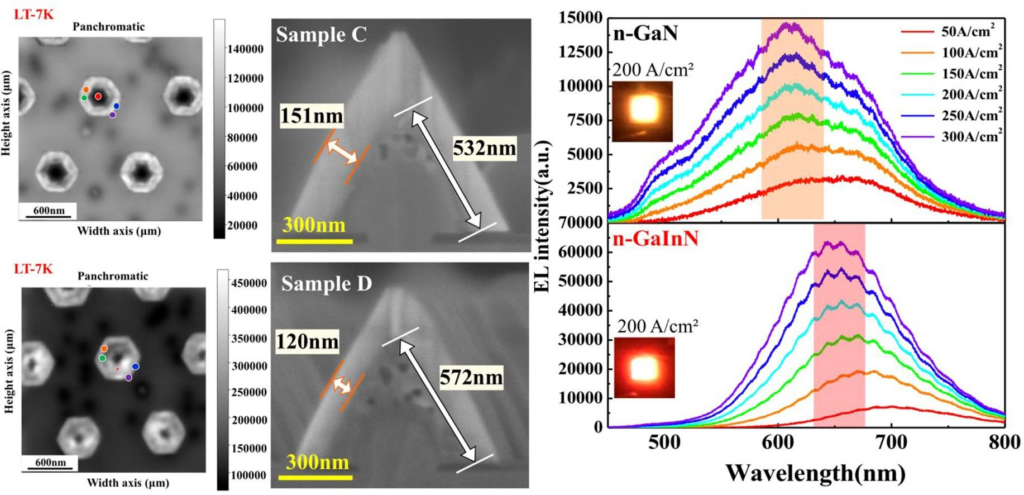Red, green, and blue MicroLEDs are made from different semiconductor materials, and these materials behave differently when it comes to efficiency. Blue and green MicroLEDs are typically based on Gallium Nitride (GaN), which has been well-developed for high-efficiency light emission. Red light, on the other hand, is often generated using AlInGaP (Aluminum Indium Gallium Phosphide). While AlInGaP works well for larger LEDs, it suffers from efficiency loss, especially when the size of the LED is reduced for MicroLED applications. GaN-based red LEDs also require high levels of Indium (In) to achieve red emission but it is also challenging to integrate into the design at the size of MicroLED.
Researchers have come up with a way to improve red light MicroLED using a special structure called GaInN (Gallium Indium Nitride) nanopyramids. The pyramid structure used in the development of these red MicroLEDs, while innovative, is not entirely unique to this specific research. Nanopyramid and nanowire structures have been explored in various semiconductor applications before.
The nanopyramids in this research are structured with a core of n-GaN (Gallium Nitride) followed by multiple quantum shells (MQS) of GaInN/GaN. This layering helps manage strain within the material, which is crucial for improving the incorporation of Indium (In) — a key element for producing efficient red light in MicroLEDs. This specific approach of using core-shell structures in the pyramid form is what gives it an edge over more. The inclusion of an n-GaInN layer in the pyramid structure helps relieve the compressive strain that typically builds up in LEDs, especially when working with Indium. Strain in semiconductor materials can cause defects that limit the efficiency of light emission, so managing it effectively is essential. This structure allows for a better distribution of Indium, enhancing red light emission.

Another important feature of the pyramid design is the orientation of its surfaces. The semipolar plane of the pyramid helps reduce the quantum-confined Stark effect (QCSE), which distorts electric fields inside the LED and reduces its performance. By using the semipolar plane instead of the more common polar plane, the researchers were able to suppress QCSE, boosting the efficiency of their red MicroLEDs. The shape of the nanopyramids naturally aids in light extraction. In conventional planar LED structures, light can be trapped inside the device, reducing efficiency. However, the pyramid shape helps light escape more easily, improving overall brightness and performance.
The researchers found that the light output from their new red MicroLED was 1.2 times brighter than its predecessors.
Reference
Inaba, S., Lu, W., Shima, A., Fukami, N., Hattori, Y., Huang, K., Iwaya, M., Takeuchi, T., & Kamiyama, S. (2025). GaInN hexagonal nanopyramid-based structures with coaxial multiple-quantum shells for red-light micro-LEDs. Applied Surface Science, 679, 161219. https://doi.org/10.1016/j.apsusc.2024.161219

